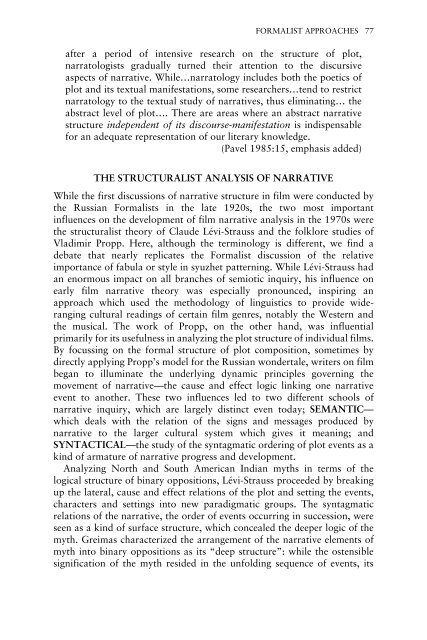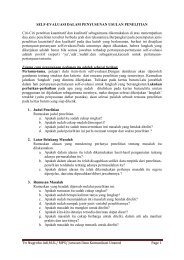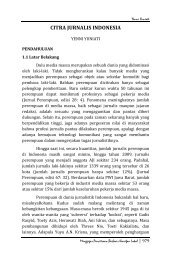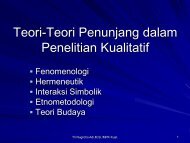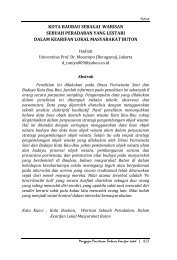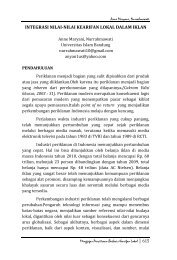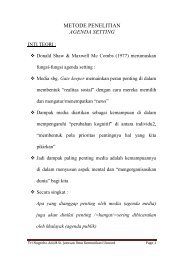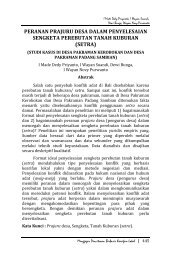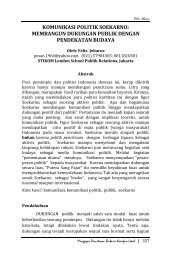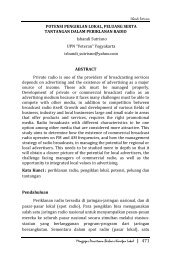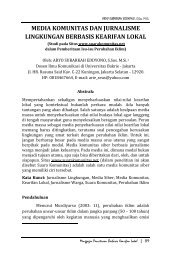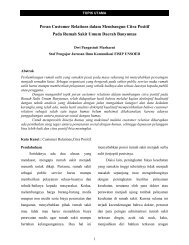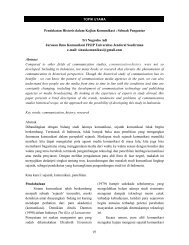New Vocabularies in Film Semiotics
New Vocabularies in Film Semiotics
New Vocabularies in Film Semiotics
You also want an ePaper? Increase the reach of your titles
YUMPU automatically turns print PDFs into web optimized ePapers that Google loves.
FORMALIST APPROACHES 77<br />
after a period of <strong>in</strong>tensive research on the structure of plot,<br />
narratologists gradually turned their attention to the discursive<br />
aspects of narrative. While…narratology <strong>in</strong>cludes both the poetics of<br />
plot and its textual manifestations, some researchers…tend to restrict<br />
narratology to the textual study of narratives, thus elim<strong>in</strong>at<strong>in</strong>g… the<br />
abstract level of plot…. There are areas where an abstract narrative<br />
structure <strong>in</strong>dependent of its discourse-manifestation is <strong>in</strong>dispensable<br />
for an adequate representation of our literary knowledge.<br />
(Pavel 1985:15, emphasis added)<br />
THE STRUCTURALIST ANALYSIS OF NARRATIVE<br />
While the first discussions of narrative structure <strong>in</strong> film were conducted by<br />
the Russian Formalists <strong>in</strong> the late 1920s, the two most important<br />
<strong>in</strong>fluences on the development of film narrative analysis <strong>in</strong> the 1970s were<br />
the structuralist theory of Claude Lévi-Strauss and the folklore studies of<br />
Vladimir Propp. Here, although the term<strong>in</strong>ology is different, we f<strong>in</strong>d a<br />
debate that nearly replicates the Formalist discussion of the relative<br />
importance of fabula or style <strong>in</strong> syuzhet pattern<strong>in</strong>g. While Lévi-Strauss had<br />
an enormous impact on all branches of semiotic <strong>in</strong>quiry, his <strong>in</strong>fluence on<br />
early film narrative theory was especially pronounced, <strong>in</strong>spir<strong>in</strong>g an<br />
approach which used the methodology of l<strong>in</strong>guistics to provide widerang<strong>in</strong>g<br />
cultural read<strong>in</strong>gs of certa<strong>in</strong> film genres, notably the Western and<br />
the musical. The work of Propp, on the other hand, was <strong>in</strong>fluential<br />
primarily for its usefulness <strong>in</strong> analyz<strong>in</strong>g the plot structure of <strong>in</strong>dividual films.<br />
By focuss<strong>in</strong>g on the formal structure of plot composition, sometimes by<br />
directly apply<strong>in</strong>g Propp’s model for the Russian wondertale, writers on film<br />
began to illum<strong>in</strong>ate the underly<strong>in</strong>g dynamic pr<strong>in</strong>ciples govern<strong>in</strong>g the<br />
movement of narrative—the cause and effect logic l<strong>in</strong>k<strong>in</strong>g one narrative<br />
event to another. These two <strong>in</strong>fluences led to two different schools of<br />
narrative <strong>in</strong>quiry, which are largely dist<strong>in</strong>ct even today; SEMANTIC—<br />
which deals with the relation of the signs and messages produced by<br />
narrative to the larger cultural system which gives it mean<strong>in</strong>g; and<br />
SYNTACTICAL—the study of the syntagmatic order<strong>in</strong>g of plot events as a<br />
k<strong>in</strong>d of armature of narrative progress and development.<br />
Analyz<strong>in</strong>g North and South American Indian myths <strong>in</strong> terms of the<br />
logical structure of b<strong>in</strong>ary oppositions, Lévi-Strauss proceeded by break<strong>in</strong>g<br />
up the lateral, cause and effect relations of the plot and sett<strong>in</strong>g the events,<br />
characters and sett<strong>in</strong>gs <strong>in</strong>to new paradigmatic groups. The syntagmatic<br />
relations of the narrative, the order of events occurr<strong>in</strong>g <strong>in</strong> succession, were<br />
seen as a k<strong>in</strong>d of surface structure, which concealed the deeper logic of the<br />
myth. Greimas characterized the arrangement of the narrative elements of<br />
myth <strong>in</strong>to b<strong>in</strong>ary oppositions as its “deep structure”: while the ostensible<br />
signification of the myth resided <strong>in</strong> the unfold<strong>in</strong>g sequence of events, its


